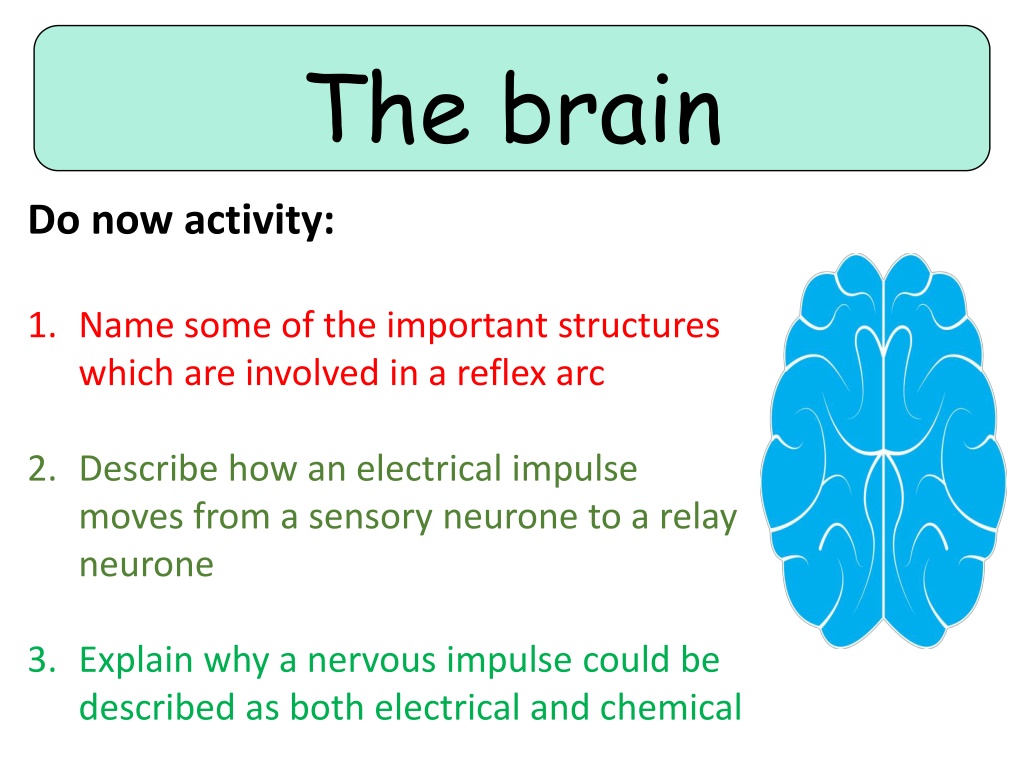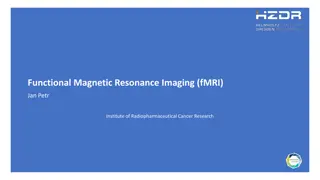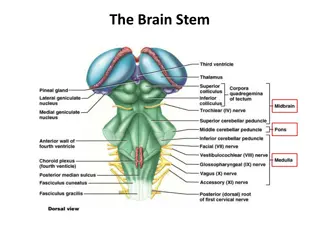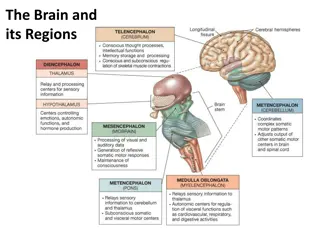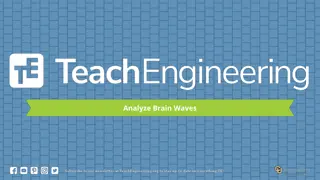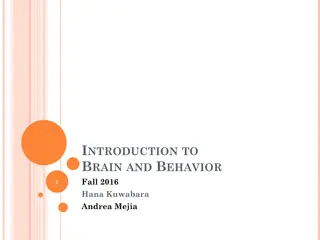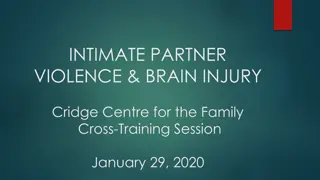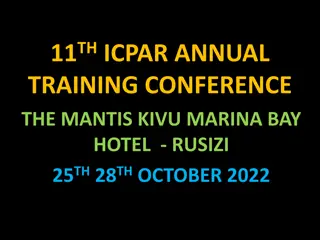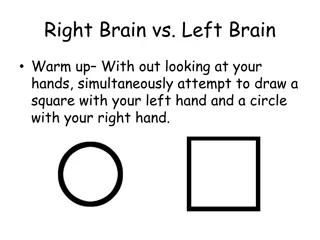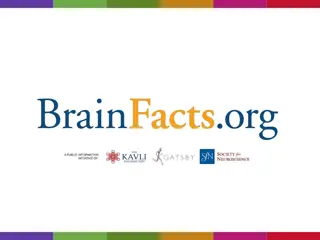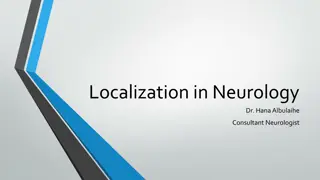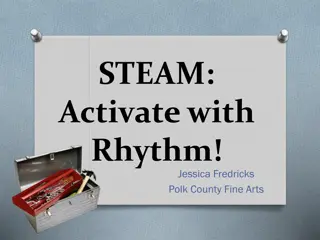Explore the Structures and Functions of the Brain
Delve into the intricate world of the brain, learning about important structures like the hypothalamus and cerebral cortex. Discover how electrical impulses move through neurons and understand the dual nature of nervous impulses. Engage in activities to map brain functions and test your knowledge with quick checks.
Download Presentation

Please find below an Image/Link to download the presentation.
The content on the website is provided AS IS for your information and personal use only. It may not be sold, licensed, or shared on other websites without obtaining consent from the author. Download presentation by click this link. If you encounter any issues during the download, it is possible that the publisher has removed the file from their server.
E N D
Presentation Transcript
The brain Do now activity: 1. Name some of the important structures which are involved in a reflex arc 2. Describe how an electrical impulse moves from a sensory neurone to a relay neurone 3. Explain why a nervous impulse could be described as both electrical and chemical
Progress indicators GOOD PROGRESS: Identify different areas within the brain Describe the function of the main areas inside the brain OUTSTANDING PROGRESS: Explain how scientists find out about the structure and functions of the brain
CORTEX Grey matter composed of ? LEFT & RIGHT CEREBRAL HEMISPHERES Frontal lobe Temporal lobe Parietal lobe Occipital lobe
Parietal lobe The two cerebral hemispheres are connected by a broad band of white matter called the corpus callosum Frontal lobe Occipital lobe Temporal lobe Task: You have each been given a set of information about each of these lobes. Talk to each other to complete the table outlining the various functions of the brain s structures
Your brain contains many intricate structures which all play integral roles. You need to know the functions of the following: Hypothalamus Cerebral cortex Cerebellum Medulla Hypothalamus Pituitary Gland Task: 1. Label your diagram of the brain cross-section to demonstrate the location of the structures above. 2. Use the posters of information around the room to describe the function of each of these structures.
Quick Check: Silent 5 1. If you were biking downhill and came across an unexpected sharp bend in the road you would need to apply the brakes or turn the handlebars to stop yourself falling. Which regions of the brain, including those in the brain stem, are involved in this subsequent action? 2. What parts of the brain would be involved in seeing and interpreting your view of the world around you? Self-assessment: 1. Frontal lobe; parietal lobe; cerebellum 2. Sensory information would be sent to the occipital lobe (visual cortex) which processes information from the eyes; the frontal lobe and parietal lobe, part of your cerebral cortex, may be involved in interpreting the information.
Task: Match the structure to the function BEFORE the end of the video on HOMUNCULUS. 1. Occipital lobe 2. Temporal lobe 3. Parietal lobe 4. Frontal lobe 5. Hypothalamus 6. Medulla oblongata 7. Cerebellum https://www.youtube.com/watch?v=fxZWtc0mYpQ
How many did you get correct?
How do we know the function of each brain region? Historically neuroscientists have collected information on how the brain works by studying pathological specimens. As time has moved on neuroscientist have begun to use animal models and by studying patients during surgery. Individual case studies of patients with brain damage will continue to provide evidence in the study of the brain but now neuroscientists can use a range of non-invasive techniques to study the function of the living brain. https://www.youtube.com/watch?v=XLGXAiSpN00
We can study individuals with damaged brain regions: E.g. Phineas Gage 1848 He went from being a popular responsible man to a foul- mouthed irresponsible and obstinate man
Task: Watch the video and answer the following questions: 1. Describe what happened to Phineas Gage. 2. Describe what his friends reported of Phineas before and after the incident. 3. Evaluate the impact of this case study on our knowledge of brain function. https://www.youtube.com/watch?v=vHrmiy4W9C0
Self-assessment: 1. Phineas Gage was blasted with an iron rod which shot through his eye and out of the back of his head, passing through part of his brain. 2. Phineas friends reported that Phineas, who was once a mild mannered, polite and softly spoken man, was now rude, angry and vulgar. His personality had changed somewhat since his brain had become damaged in the incident 3. This case study does provide us with evidence that there are localised areas in the brain dedicated to specific functions, which relate to our psychology. However, this is an individual case-study which occurred many years ago and we do not have any data on how Phineas was before or even after the accident.
Electrically stimulating parts of the brain Electrically stimulating parts of the brain can be achieved by removing the top of a patients skull and placing electrodes on a particular area of the brain. A similar effect can also be achieved by a more recent technology which uses magnetic stimulation to stimulate parts of the brain. People can experience hunger, thirst, anger or fear simply because that area of the brain is stimulated. This is carried out on conscious patients and it helps scientists to build a better picture of the function of specific parts of the brain. https://www.youtube.com/watch?v=KKuS1TLhtGg
MRI scans MRI scans have enabled scientists to develop a better understanding of how the brain works. An magnetic resonance imaging (MRI) scan takes images of the brain in living people and enable scientists to link the loss of a certain function, e.g. speech or hearing, with a specific region of the brain. The most recent MRI scanners are able to take live images of patients whilst they are undertaking a particular task.
Treating problems with the brain The brain is incredibly complex and can be easily damaged. Scientists and doctors do what they can to diagnose and treat conditions related to the brain but it is an incredibly delicate process. As it is still not fully understood which parts of the brain carry out which functions surgery can be incredibly difficult and damaging to a patients life.
Task: Fill in the blanks on your worksheet: Key Words: case studies of people with brain damage, animal models, non-invasive techniques, pathological specimens, studying patients during surgery How do we know the function of each brain region? Historically neuroscientists have collected information on how the brain works by studying ____________. As time has moved on neuroscientist have began to use ________ and by ________________________. Individual ____________________________ will continue to provide evidence in the study of the brain but now neuroscientists can use a range of ______________ to study the function of the living brain.
Self-assessment: Historically neuroscientists have collected information on how the brain works by studying pathological specimens. As time has moved on neuroscientist have began to use animal models and by studying patients during surgery. Individual case studies of patients with brain damage will continue to provide evidence in the study of the brain but now neuroscientists can use a range of non-invasive techniques to study the function of the living brain.
Plenary 6-mark exam question Q. Discuss the ways in which scientists can find out about the functions of the different areas of the brain. (6 marks)
Frontal Lobe: Concerned with higher brain functions such as decision making, reasoning, planning and consciousness of emotions. It is also concerned with forming associations and with ideas It includes the primary motor cortex, this has neurones directly linked to the spinal cord and brain stem and from there to the muscles. It sends information to the body via the motor neurones to carry out movements. The motor cortex also stores information about how to carry our different movements Parietal Lobe: Concerned with orientation, movement, sensation, calculation and some types of recognition and memory Temporal Lobe: Concerned with processing auditory information i.e. hearing, sound recognition and speech (left temporal lobe). Also involved in memory Occipital Lobe: (visual cortex) concerned with processing information from the eyes, including vision, colour, shape recognition and perspective. To be cut up into a card sort for Activity 1
The hypothalamus holds the thermoregulatory centre which is needed for control of body temperature. As well as this it is also controls thirst, hunger and sleep. The cerebellum is required for coordination of muscular activity and also balance.
The cerebral cortex us concerned with a vast array of functions. Mainly including consciousness, intelligence, memory and language. The medulla is concerned with unconscious activities, such as controlling the heartbeat, the movements of the gut and breathing and blood pressure
